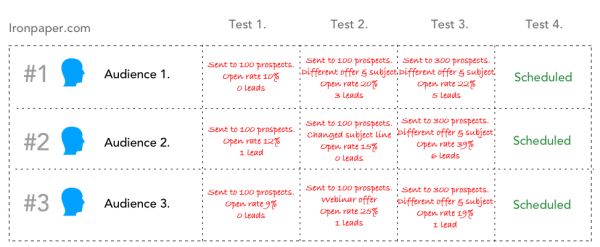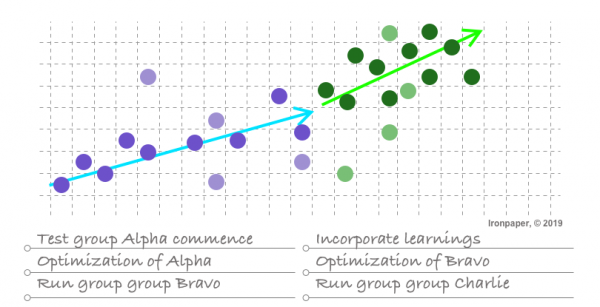
Iteration and optimization are the two words that should define your account-based marketing campaign. If you want to lower your cost-per-acquisition and scale up reliably, you need to be lean with your campaign launch and test from a few different angles.

Not even the most seasoned marketers or industry experts can know exactly what will resonate with their target accounts until they test it. That's why you shouldn't pour all of your budget into one campaign and simply hope for the best -- in fact, that’s one of several ABM mistakes to avoid.
Particularly when you target and capture a specific audience, iteration and refinement over time are both key. And no successful campaign is “set it and forget it.” Instead, you should be running a variety of major tests for your account based marketing campaign:
Even if you have a huge and very specific list of target accounts for your ABM campaign, there are many configurations for how you can test audience targeting. Here are some examples:
Since you don’t want the same audience to be too inundated with your ads, it’s fine to try variations of audience testing in succession, not all at once. But don’t overlook the campaign boost you can get with audience segmentation, and try different iterations to see what converts best.

Furthermore, you might run into some platform limitations with your audience, and then you’ll need to get creative. For example, if you don’t meet the minimum number of target accounts or email addresses required to run a campaign, you will need to build a new audience from scratch. However, you can base this audience on relevant traits, such as company size, company name, job title, and more -- closely matching your original list.
Account-based marketing is about so much more than prospecting emails. There are numerous platforms for ABM campaigns, including but not limited to the following:
You may think you have an inclination about what platform works better. But like most variables with your campaign, you should be testing to see what really resonates.
Ultimately, you should be running a campaign on at least 2-3 different ABM networks. Then you can look at results and invest more there.
As your main KPIs between networks, you should be testing platforms to compare cost per acquisition, quality of leads, and the number of impressions you can achieve. While CPA and quality are the most important metrics, if you're limited by impressions, you simply can't scale.
Messaging is arguably the most important metric you can test because good messaging can have one of the biggest effects on your results. Every ABM campaign requires rigorous testing on your messaging.

To uncover the best direction to scale, you should test a variety of messaging points. These should loosely be based around:
Depending on the ABM platform you're running campaigns on, you will have the option to test messaging in a variety of places. For example, in an AdWords campaign, you can test AdGroup messaging for your keyword targets, ad copy, and very importantly, the messaging on your landing pages.
Overall, each respective test should have messaging consistent from the first touch point (ad copy) to the final conversion (the landing page or form that you drive people to.) This will keep the story unified and will help drive conversions from clicks. Then, you can also properly compare the impact of one messaging strategy through the entire conversion funnel.
The more research you do on your target accounts ahead of time, the better positioned you will be to test messaging that is more impactful, and faster.
Creative testing is often the most basic element to test, but you shouldn't overlook the opportunity to get an uptick in conversions with design iterations.
At Ironpaper, we've found that specific design styles converted 3x as many leads as other designs when advertising on LinkedIn Lead Generation.
Test a variety of elements, including color, fonts, button stylings, contrast, and how you present your conversion point. For example, if you're advertising an eBook for your ABM campaign, will you show a mocked-up "book cover" on your ad? Or will you use a pull quote or statistical representation?
Trying a range of designs with similar messaging can tell you if there are commonalities to use when you scale up your efforts.
Your budget is the backbone of your campaign. So you should have reliable knowledge on the impact of budget on your campaign's reach.
Contrary to what many people think when running a paid campaign, you can't simply scale based on budget alone. For many networks, there are "caps" based on ad quality, not budget. So make sure you've tested your other variables until you have advertising that resonates with high click-through rates, conversion rates, and/or quality scores.
First, start lean with your budgets -- only allocate a small amount per day across channels. Soon, you will see which channels are "maxing out" their daily or total budgets. If the lead quality is good on those channels, you can put more budget in over time.
Once you've generated enough insights into high-performing ads across networks, you can put more budget into those channels with low cost-per-acquisition AND quality leads. It's a careful balance: On one hand, you want a decent quantity of new leads -- but on the other hand, you don't want to pay for junk. For example, just because you have leads coming in from a target company doesn't mean those leads are all decision-makers or working in a relevant department.
Account-based marketing will be very successful for you if you think about iteration and optimization. No campaign should have only one creative design, or one messaging focus, or a standardized budget. The more you can fine-tune each element of your digital marketing campaign, the more successful you will be.
by Jonathan Franchell, CEO of Ironpaper - For more tips and hacks: Need to remove a new line after h1 tags? Both web designers and SEO practitioners need to employ headline tags: H1, H2, H3 in several ways to improve web page structure and tag...

The marketing industry is transforming significantly due to generative AI and increasing market complexity. Gartner's prediction of a 25% decline in traditional search traffic suggests that the era of search engines is dying. AI tools, particularly...

The Crowded Arena of the IT Marketplace Updated December 2024 The Information Technology (IT) landscape is experiencing rapid growth and intensifying competition. IT spending is projected to reach nearly 5.1 trillion U.S. dollars in 2024, a...

Updated December, 2024 The field of digital marketing is evolving rapidly in response to new technology and changing buyer expectations. To help career-minded marketers, we’ve rounded up the top 10 skills needed to succeed in the field. These are...
